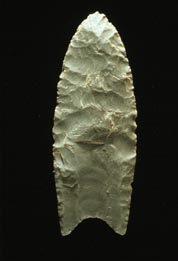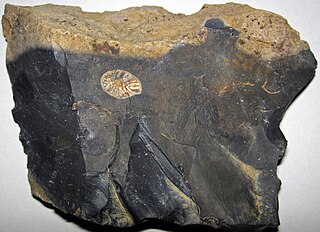
Bilzingsleben is a former stone quarry in Thuringia, Germany, notable for its wealth of palaeolithic human fossils and artifacts.

Clovis culture is a prehistoric Paleoamerican archaeological culture, named for distinct stone and bone tools found in close association with Pleistocene fauna, particularly two Columbian mammoths, at Blackwater Locality No. 1 near Clovis, New Mexico, in 1936 and 1937, though Paleoindian artifacts had been found at the site since the 1920s. It existed from roughly 11,500 to 10,800 BCE near the end of the Last Glacial Period.

Paleo-Indians or Paleo-Americans were the first peoples who entered, and subsequently inhabited, the Americas during the final glacial episodes of the late Pleistocene period. The prefix paleo- comes from the Ancient Greek adjective: παλαιός, romanized: palaiós, lit. 'old; ancient'. The term Paleo-Indians applies specifically to the lithic period in the Western Hemisphere and is distinct from the term Paleolithic.

The Folsom tradition is a Paleo-Indian archaeological culture that occupied much of central North America from c. 10800 BCE to c. 10200 BCE. The term was first used in 1927 by Jesse Dade Figgins, director of the Denver Museum of Nature and Science. The discovery by archaeologists of projectile points in association with the bones of extinct Bison antiquus, especially at the Folsom site near Folsom, New Mexico, established much greater antiquity for human residence in the Americas than the previous scholarly opinion that humans in the Americas dated back only 3,000 years. The findings at the Folsom site have been called the "discovery that changed American archaeology."

The Grotte du Lazaret is an archaeological cave site of prehistoric human occupation study, situated in the eastern suburbs of the French town of Nice, overlooking the Mediterranean Sea. Results of excavations have been interpreted as to account for the construction of shelters by humans during the Lower Paleolithic period. Research teams have unearthed more than 20,000 fossilized faunal bone fragments.

Lubbock Lake Landmark, also known as Lubbock Lake Site, is an important archeological site and natural history preserve in the city of Lubbock, Texas, United States. The protected state and federal landmark is 336 acres (136 ha). There is evidence of ancient people and extinct animals at Lubbock Lake Landmark. It has evidence of nearly 12,000 years of use by ancient cultures on the Llano Estacado. It is part of the Museum of Texas Tech University.

The Stanfield-Worley Bluff Shelter, located on private property in Colbert County in northwestern Alabama, United States, is one of the most important prehistoric sites excavated in the state due to the archeological evidence deposited by the Paleo-Indians who once occupied the rock shelter. Lying in Sanderson Cove along a tributary of Cane Creek approximately seven miles (11 km) south of the Tennessee Valley, the shelter and the high bluffs of the surrounding valley provided a well-protected environment for the Native American occupants.

The Lindenmeier site is a stratified multi-component archaeological site most famous for its Folsom component. The former Lindenmeier Ranch is in the Soapstone Prairie Natural Area, in northeastern Larimer County, Colorado, United States. The site contains the most extensive Folsom culture campsite yet found with calibrated radiocarbon dates of c. 12,300 B.P.. Artifacts were also found from subsequent Archaic and Late pre-historic periods.

Cueva Fell or Fell'sCave is a natural cave and archaeological site in southern Patagonia. Cueva Fell is in proximity to the Pali Aike Crater, another significant archaeological site. Cueva Fell combined with the nearby Pali Aike site have been submitted to UNESCO as a possible World Heritage Site.
North American hunting technologies begins with the arrival of the Paleo-Indians and continues through to modern times. This article deals exclusively with Aboriginal Canadians and Native Americans in the United States.
The Buttermilk Creek complex is the remains of a paleolithic settlement along the shores of Buttermilk Creek in present-day Salado, Texas, dated to approximately 15,500 years old. If confirmed, the site represents evidence of human settlement in the Americas that pre-dates the Clovis culture.
The Olsen–Chubbuck Bison kill site is a Paleo-Indian site that dates to an estimated 8000–6500 B.C. and provides evidence for bison hunting and using a game drive system, long before the use of the bow and arrow or horses. The site holds a bone bed of nearly 200 bison that were killed, butchered, and consumed by Paleo-Indian hunters. The site is located 16 miles southeast of Kit Carson, Colorado. The site was named after archaeologists, Sigurd Olsen and Gerald Chubbuck, who discovered the bone bed in 1957. In 1958, the excavation of the Olsen-Chubbuck site was then turned over to the University of Colorado Museum of Natural History, a team led by Joe Ben Wheat, an anthropologist employed by the museum.
Franktown Cave is located 25 miles (40 km) south of Denver, Colorado on the north edge of the Palmer Divide. It is the largest rock shelter documented on the Palmer Divide, which contains artifacts from many prehistoric cultures. Prehistoric hunter-gatherers occupied Franktown Cave intermittently for 8,000 years beginning about 6400 BC The site held remarkable lithic and ceramic artifacts, but it is better known for its perishable artifacts, including animal hides, wood, fiber and corn. Material goods were produced for their comfort, task-simplification and religious celebration. There is evidence of the site being a campsite or dwelling as recently as AD 1725.

The Jones-Miller Bison Kill Site, located in northeast Colorado, was a Paleo-Indian site where Bison antiquus were killed using a game drive system and butchered. Hell Gap complex bones and tools artifacts at the site are carbon dated from about ca. 8000-8050 BC.

Lamb Spring is a pre-Clovis prehistoric Paleo-Indian archaeological site located in Douglas County, Colorado with the largest collection of Columbian mammoth bones in the state. Lamb Spring also provides evidence of Paleo-Indian hunting in a later period by the Cody culture complex group. Lamb Spring was listed in 1997 on the National Register of Historic Places.
The Cutler Fossil Site (8DA2001) is a sinkhole near Biscayne Bay in Palmetto Bay, Florida, which is south of Miami. The site has yielded bones of Pleistocene animals and bones as well as artifacts of Paleo-Indians and people of the Archaic period.
Domebo Canyon, Oklahoma is a Paleo-Indian archaeological site: the site of a mammoth kill in the prairie of southwestern Oklahoma. The Domebo archaeological site features deposits of both incomplete and partially articulated mammoth skeletal remains. Also found at the site were two complete and one fragmentary projectile point, along with three un-worked tool flakes made by prehistoric hunters who lived during the Pleistocene Epoch.

The Noisetier Cave, owing its popular name to the Hazel trees that grow in front of its entrance, is located in a mountainside 145 m (476 ft) atop the Vallée d'Aure in the Ardengost commune, Hautes-Pyrénées department in the region Occitania, Southern France. During systematic excavations since 1992 Middle Paleolithic stone tools and artifacts attributed to the Neanderthal Mousterian culture were discovered among numerous faunal remains.
Sheriden Cave is a Paleo-Indian archaeological site from the late Ice age in Wyandot County, Ohio. Glacial deposits sealed off the cave more than 10,000 years ago. Sheriden Cave is a karst sinkhole on a dolomite ridge that crosses Hancock and Wyandot Counties. It is associated with the Indian Trail Caverns that opened in 1927. Sheriden Cave was discovered in 1989. The cave is unique because in addition to stone tools, there were also bone tools, remains of extinct animals, and organic matter found in the cave. Radiocarbon dating of artifacts indicate that they were used 11,000 and 12,000 years ago.

The Welling site is an archaeological site of the Paleo-Indian period, meaning the time of the earliest humans. Located in Coshocton County, Ohio, it was a site for quarrying stone in the Upper Mercer chert source area. Based upon the microwear analysis of stone tools, it is believed to be a base camp where people learned and shared Clovis tool-making techniques, ate, exchanged information, and perhaps found mates from others groups.